Business Information Technology Systems and Organizational Growth
VerifiedAdded on 2023/01/18
|13
|4260
|97
Report
AI Summary
This report examines the critical role of Information Technology (IT) within business operations, using British Home Plc as a case study. It explores the utilization of IT across various organizational functions, such as HR, finance, and marketing, and analyzes its contribution to achieving predetermined business objectives. The report delves into the specific roles of IT in customer relationship management (CRM), communication, and data management, highlighting both advantages and disadvantages of these applications. Furthermore, it investigates how IT systems can support value-added changes to improve performance, sustainability, and overall business operations, culminating in practical recommendations for IT solutions to address common business challenges. The report emphasizes the importance of IT for innovation, efficient operations, enhanced security, and the capacity to conduct research, ultimately illustrating how IT contributes to a business's ability to achieve its goals.
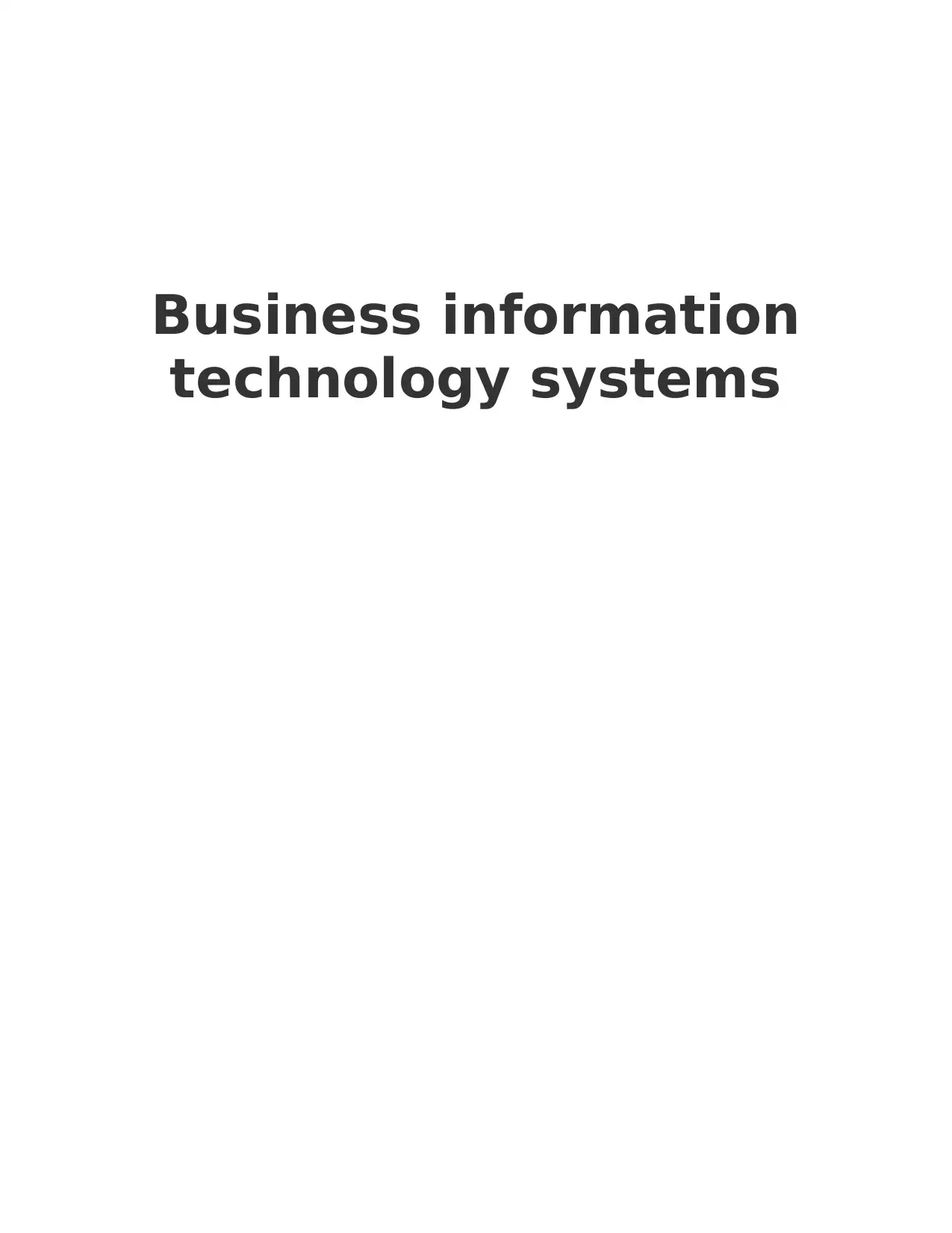
Business information
technology systems
technology systems
Paraphrase This Document
Need a fresh take? Get an instant paraphrase of this document with our AI Paraphraser
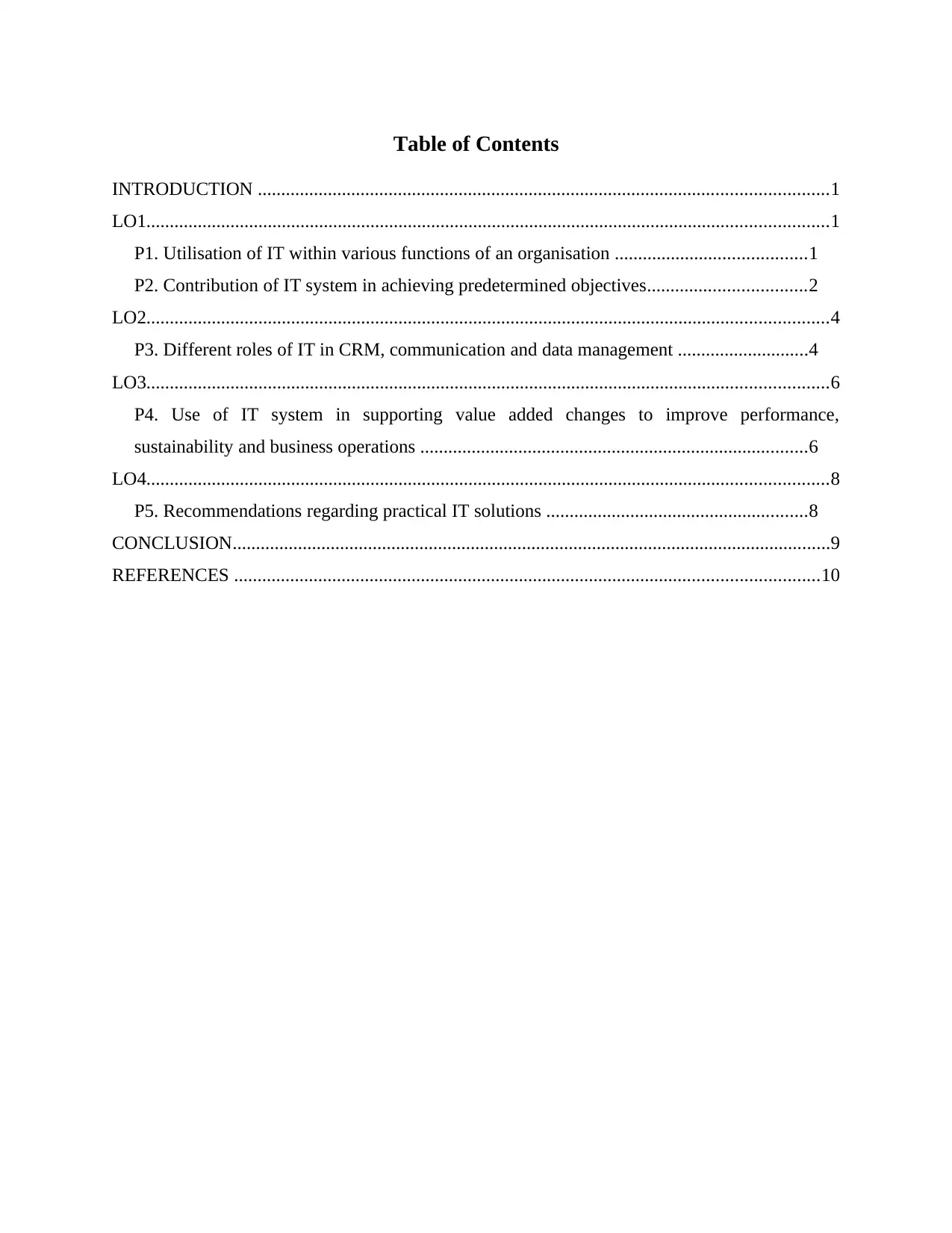
Table of Contents
INTRODUCTION ..........................................................................................................................1
LO1..................................................................................................................................................1
P1. Utilisation of IT within various functions of an organisation .........................................1
P2. Contribution of IT system in achieving predetermined objectives..................................2
LO2..................................................................................................................................................4
P3. Different roles of IT in CRM, communication and data management ............................4
LO3..................................................................................................................................................6
P4. Use of IT system in supporting value added changes to improve performance,
sustainability and business operations ...................................................................................6
LO4..................................................................................................................................................8
P5. Recommendations regarding practical IT solutions ........................................................8
CONCLUSION................................................................................................................................9
REFERENCES .............................................................................................................................10
INTRODUCTION ..........................................................................................................................1
LO1..................................................................................................................................................1
P1. Utilisation of IT within various functions of an organisation .........................................1
P2. Contribution of IT system in achieving predetermined objectives..................................2
LO2..................................................................................................................................................4
P3. Different roles of IT in CRM, communication and data management ............................4
LO3..................................................................................................................................................6
P4. Use of IT system in supporting value added changes to improve performance,
sustainability and business operations ...................................................................................6
LO4..................................................................................................................................................8
P5. Recommendations regarding practical IT solutions ........................................................8
CONCLUSION................................................................................................................................9
REFERENCES .............................................................................................................................10
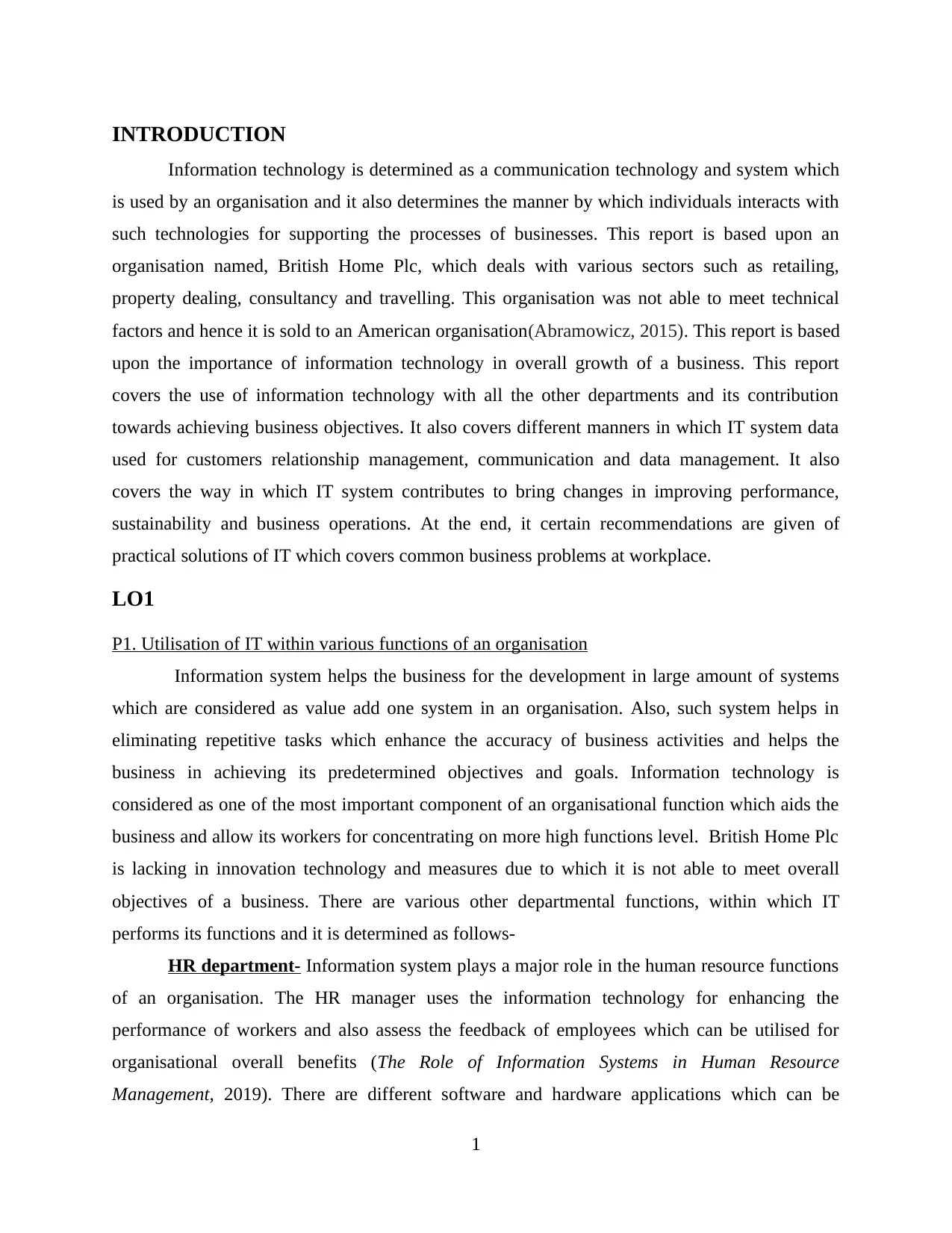
INTRODUCTION
Information technology is determined as a communication technology and system which
is used by an organisation and it also determines the manner by which individuals interacts with
such technologies for supporting the processes of businesses. This report is based upon an
organisation named, British Home Plc, which deals with various sectors such as retailing,
property dealing, consultancy and travelling. This organisation was not able to meet technical
factors and hence it is sold to an American organisation(Abramowicz, 2015). This report is based
upon the importance of information technology in overall growth of a business. This report
covers the use of information technology with all the other departments and its contribution
towards achieving business objectives. It also covers different manners in which IT system data
used for customers relationship management, communication and data management. It also
covers the way in which IT system contributes to bring changes in improving performance,
sustainability and business operations. At the end, it certain recommendations are given of
practical solutions of IT which covers common business problems at workplace.
LO1
P1. Utilisation of IT within various functions of an organisation
Information system helps the business for the development in large amount of systems
which are considered as value add one system in an organisation. Also, such system helps in
eliminating repetitive tasks which enhance the accuracy of business activities and helps the
business in achieving its predetermined objectives and goals. Information technology is
considered as one of the most important component of an organisational function which aids the
business and allow its workers for concentrating on more high functions level. British Home Plc
is lacking in innovation technology and measures due to which it is not able to meet overall
objectives of a business. There are various other departmental functions, within which IT
performs its functions and it is determined as follows-
HR department- Information system plays a major role in the human resource functions
of an organisation. The HR manager uses the information technology for enhancing the
performance of workers and also assess the feedback of employees which can be utilised for
organisational overall benefits (The Role of Information Systems in Human Resource
Management, 2019). There are different software and hardware applications which can be
1
Information technology is determined as a communication technology and system which
is used by an organisation and it also determines the manner by which individuals interacts with
such technologies for supporting the processes of businesses. This report is based upon an
organisation named, British Home Plc, which deals with various sectors such as retailing,
property dealing, consultancy and travelling. This organisation was not able to meet technical
factors and hence it is sold to an American organisation(Abramowicz, 2015). This report is based
upon the importance of information technology in overall growth of a business. This report
covers the use of information technology with all the other departments and its contribution
towards achieving business objectives. It also covers different manners in which IT system data
used for customers relationship management, communication and data management. It also
covers the way in which IT system contributes to bring changes in improving performance,
sustainability and business operations. At the end, it certain recommendations are given of
practical solutions of IT which covers common business problems at workplace.
LO1
P1. Utilisation of IT within various functions of an organisation
Information system helps the business for the development in large amount of systems
which are considered as value add one system in an organisation. Also, such system helps in
eliminating repetitive tasks which enhance the accuracy of business activities and helps the
business in achieving its predetermined objectives and goals. Information technology is
considered as one of the most important component of an organisational function which aids the
business and allow its workers for concentrating on more high functions level. British Home Plc
is lacking in innovation technology and measures due to which it is not able to meet overall
objectives of a business. There are various other departmental functions, within which IT
performs its functions and it is determined as follows-
HR department- Information system plays a major role in the human resource functions
of an organisation. The HR manager uses the information technology for enhancing the
performance of workers and also assess the feedback of employees which can be utilised for
organisational overall benefits (The Role of Information Systems in Human Resource
Management, 2019). There are different software and hardware applications which can be
1
⊘ This is a preview!⊘
Do you want full access?
Subscribe today to unlock all pages.

Trusted by 1+ million students worldwide
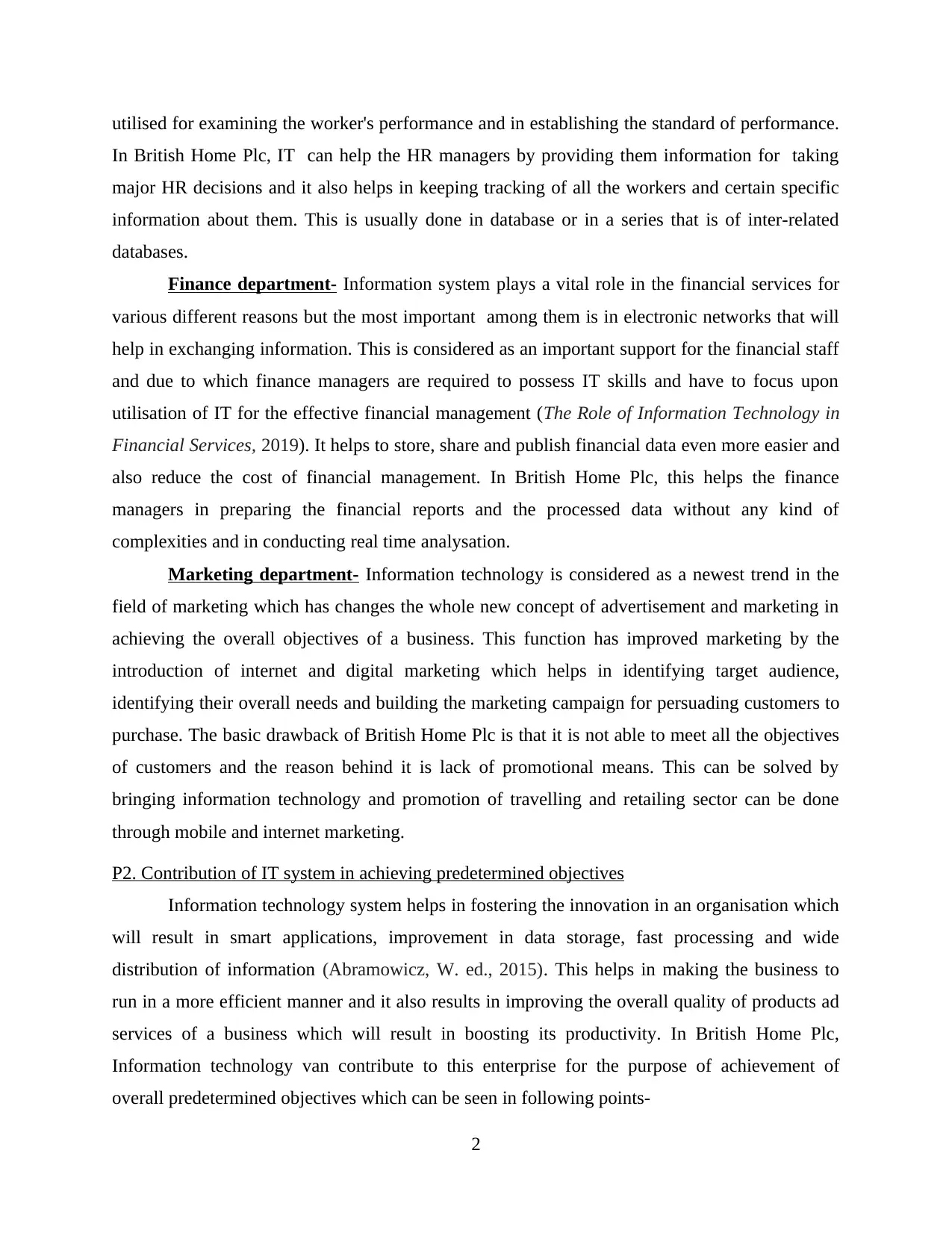
utilised for examining the worker's performance and in establishing the standard of performance.
In British Home Plc, IT can help the HR managers by providing them information for taking
major HR decisions and it also helps in keeping tracking of all the workers and certain specific
information about them. This is usually done in database or in a series that is of inter-related
databases.
Finance department- Information system plays a vital role in the financial services for
various different reasons but the most important among them is in electronic networks that will
help in exchanging information. This is considered as an important support for the financial staff
and due to which finance managers are required to possess IT skills and have to focus upon
utilisation of IT for the effective financial management (The Role of Information Technology in
Financial Services, 2019). It helps to store, share and publish financial data even more easier and
also reduce the cost of financial management. In British Home Plc, this helps the finance
managers in preparing the financial reports and the processed data without any kind of
complexities and in conducting real time analysation.
Marketing department- Information technology is considered as a newest trend in the
field of marketing which has changes the whole new concept of advertisement and marketing in
achieving the overall objectives of a business. This function has improved marketing by the
introduction of internet and digital marketing which helps in identifying target audience,
identifying their overall needs and building the marketing campaign for persuading customers to
purchase. The basic drawback of British Home Plc is that it is not able to meet all the objectives
of customers and the reason behind it is lack of promotional means. This can be solved by
bringing information technology and promotion of travelling and retailing sector can be done
through mobile and internet marketing.
P2. Contribution of IT system in achieving predetermined objectives
Information technology system helps in fostering the innovation in an organisation which
will result in smart applications, improvement in data storage, fast processing and wide
distribution of information (Abramowicz, W. ed., 2015). This helps in making the business to
run in a more efficient manner and it also results in improving the overall quality of products ad
services of a business which will result in boosting its productivity. In British Home Plc,
Information technology van contribute to this enterprise for the purpose of achievement of
overall predetermined objectives which can be seen in following points-
2
In British Home Plc, IT can help the HR managers by providing them information for taking
major HR decisions and it also helps in keeping tracking of all the workers and certain specific
information about them. This is usually done in database or in a series that is of inter-related
databases.
Finance department- Information system plays a vital role in the financial services for
various different reasons but the most important among them is in electronic networks that will
help in exchanging information. This is considered as an important support for the financial staff
and due to which finance managers are required to possess IT skills and have to focus upon
utilisation of IT for the effective financial management (The Role of Information Technology in
Financial Services, 2019). It helps to store, share and publish financial data even more easier and
also reduce the cost of financial management. In British Home Plc, this helps the finance
managers in preparing the financial reports and the processed data without any kind of
complexities and in conducting real time analysation.
Marketing department- Information technology is considered as a newest trend in the
field of marketing which has changes the whole new concept of advertisement and marketing in
achieving the overall objectives of a business. This function has improved marketing by the
introduction of internet and digital marketing which helps in identifying target audience,
identifying their overall needs and building the marketing campaign for persuading customers to
purchase. The basic drawback of British Home Plc is that it is not able to meet all the objectives
of customers and the reason behind it is lack of promotional means. This can be solved by
bringing information technology and promotion of travelling and retailing sector can be done
through mobile and internet marketing.
P2. Contribution of IT system in achieving predetermined objectives
Information technology system helps in fostering the innovation in an organisation which
will result in smart applications, improvement in data storage, fast processing and wide
distribution of information (Abramowicz, W. ed., 2015). This helps in making the business to
run in a more efficient manner and it also results in improving the overall quality of products ad
services of a business which will result in boosting its productivity. In British Home Plc,
Information technology van contribute to this enterprise for the purpose of achievement of
overall predetermined objectives which can be seen in following points-
2
Paraphrase This Document
Need a fresh take? Get an instant paraphrase of this document with our AI Paraphraser
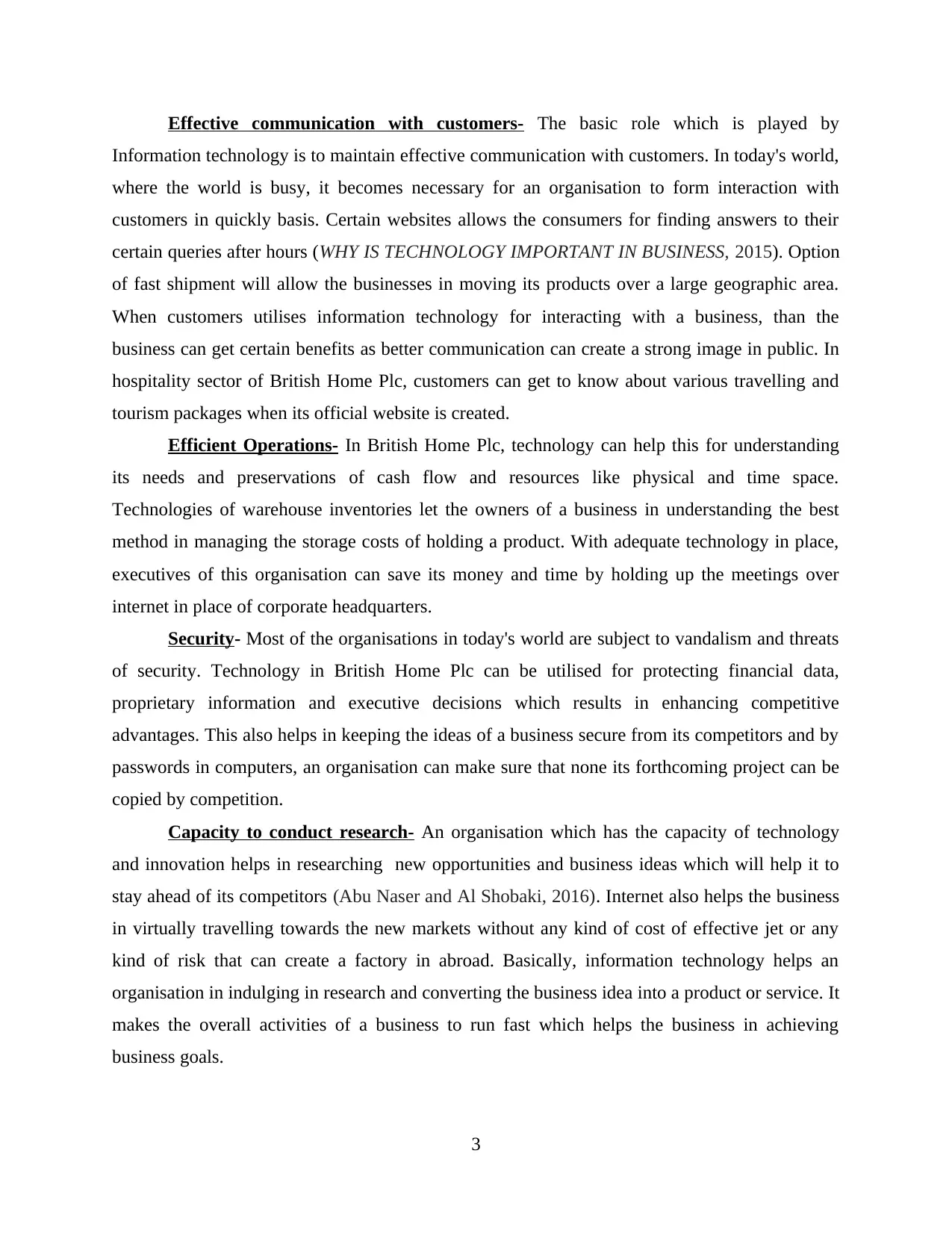
Effective communication with customers- The basic role which is played by
Information technology is to maintain effective communication with customers. In today's world,
where the world is busy, it becomes necessary for an organisation to form interaction with
customers in quickly basis. Certain websites allows the consumers for finding answers to their
certain queries after hours (WHY IS TECHNOLOGY IMPORTANT IN BUSINESS, 2015). Option
of fast shipment will allow the businesses in moving its products over a large geographic area.
When customers utilises information technology for interacting with a business, than the
business can get certain benefits as better communication can create a strong image in public. In
hospitality sector of British Home Plc, customers can get to know about various travelling and
tourism packages when its official website is created.
Efficient Operations- In British Home Plc, technology can help this for understanding
its needs and preservations of cash flow and resources like physical and time space.
Technologies of warehouse inventories let the owners of a business in understanding the best
method in managing the storage costs of holding a product. With adequate technology in place,
executives of this organisation can save its money and time by holding up the meetings over
internet in place of corporate headquarters.
Security- Most of the organisations in today's world are subject to vandalism and threats
of security. Technology in British Home Plc can be utilised for protecting financial data,
proprietary information and executive decisions which results in enhancing competitive
advantages. This also helps in keeping the ideas of a business secure from its competitors and by
passwords in computers, an organisation can make sure that none its forthcoming project can be
copied by competition.
Capacity to conduct research- An organisation which has the capacity of technology
and innovation helps in researching new opportunities and business ideas which will help it to
stay ahead of its competitors (Abu Naser and Al Shobaki, 2016). Internet also helps the business
in virtually travelling towards the new markets without any kind of cost of effective jet or any
kind of risk that can create a factory in abroad. Basically, information technology helps an
organisation in indulging in research and converting the business idea into a product or service. It
makes the overall activities of a business to run fast which helps the business in achieving
business goals.
3
Information technology is to maintain effective communication with customers. In today's world,
where the world is busy, it becomes necessary for an organisation to form interaction with
customers in quickly basis. Certain websites allows the consumers for finding answers to their
certain queries after hours (WHY IS TECHNOLOGY IMPORTANT IN BUSINESS, 2015). Option
of fast shipment will allow the businesses in moving its products over a large geographic area.
When customers utilises information technology for interacting with a business, than the
business can get certain benefits as better communication can create a strong image in public. In
hospitality sector of British Home Plc, customers can get to know about various travelling and
tourism packages when its official website is created.
Efficient Operations- In British Home Plc, technology can help this for understanding
its needs and preservations of cash flow and resources like physical and time space.
Technologies of warehouse inventories let the owners of a business in understanding the best
method in managing the storage costs of holding a product. With adequate technology in place,
executives of this organisation can save its money and time by holding up the meetings over
internet in place of corporate headquarters.
Security- Most of the organisations in today's world are subject to vandalism and threats
of security. Technology in British Home Plc can be utilised for protecting financial data,
proprietary information and executive decisions which results in enhancing competitive
advantages. This also helps in keeping the ideas of a business secure from its competitors and by
passwords in computers, an organisation can make sure that none its forthcoming project can be
copied by competition.
Capacity to conduct research- An organisation which has the capacity of technology
and innovation helps in researching new opportunities and business ideas which will help it to
stay ahead of its competitors (Abu Naser and Al Shobaki, 2016). Internet also helps the business
in virtually travelling towards the new markets without any kind of cost of effective jet or any
kind of risk that can create a factory in abroad. Basically, information technology helps an
organisation in indulging in research and converting the business idea into a product or service. It
makes the overall activities of a business to run fast which helps the business in achieving
business goals.
3
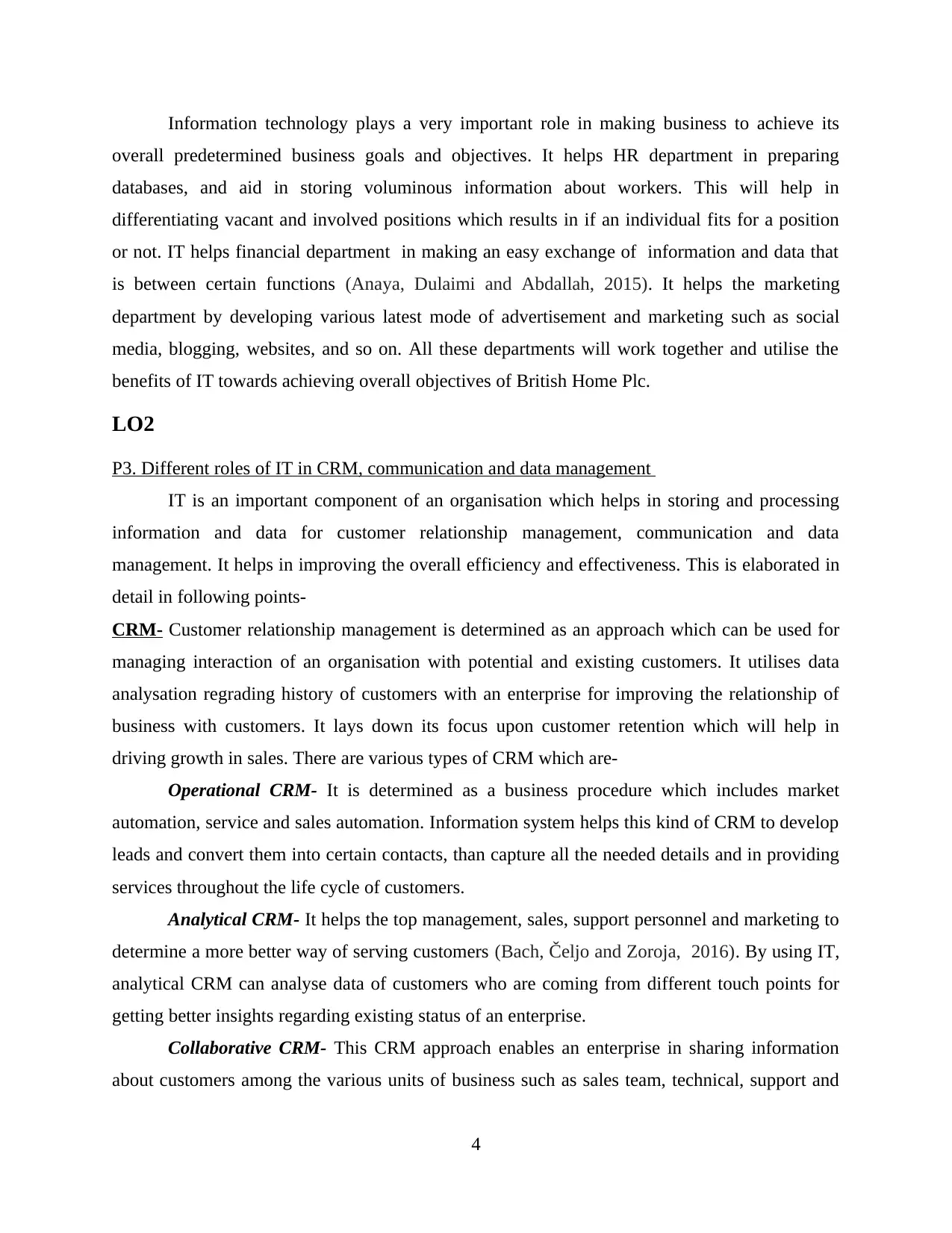
Information technology plays a very important role in making business to achieve its
overall predetermined business goals and objectives. It helps HR department in preparing
databases, and aid in storing voluminous information about workers. This will help in
differentiating vacant and involved positions which results in if an individual fits for a position
or not. IT helps financial department in making an easy exchange of information and data that
is between certain functions (Anaya, Dulaimi and Abdallah, 2015). It helps the marketing
department by developing various latest mode of advertisement and marketing such as social
media, blogging, websites, and so on. All these departments will work together and utilise the
benefits of IT towards achieving overall objectives of British Home Plc.
LO2
P3. Different roles of IT in CRM, communication and data management
IT is an important component of an organisation which helps in storing and processing
information and data for customer relationship management, communication and data
management. It helps in improving the overall efficiency and effectiveness. This is elaborated in
detail in following points-
CRM- Customer relationship management is determined as an approach which can be used for
managing interaction of an organisation with potential and existing customers. It utilises data
analysation regrading history of customers with an enterprise for improving the relationship of
business with customers. It lays down its focus upon customer retention which will help in
driving growth in sales. There are various types of CRM which are-
Operational CRM- It is determined as a business procedure which includes market
automation, service and sales automation. Information system helps this kind of CRM to develop
leads and convert them into certain contacts, than capture all the needed details and in providing
services throughout the life cycle of customers.
Analytical CRM- It helps the top management, sales, support personnel and marketing to
determine a more better way of serving customers (Bach, Čeljo and Zoroja, 2016). By using IT,
analytical CRM can analyse data of customers who are coming from different touch points for
getting better insights regarding existing status of an enterprise.
Collaborative CRM- This CRM approach enables an enterprise in sharing information
about customers among the various units of business such as sales team, technical, support and
4
overall predetermined business goals and objectives. It helps HR department in preparing
databases, and aid in storing voluminous information about workers. This will help in
differentiating vacant and involved positions which results in if an individual fits for a position
or not. IT helps financial department in making an easy exchange of information and data that
is between certain functions (Anaya, Dulaimi and Abdallah, 2015). It helps the marketing
department by developing various latest mode of advertisement and marketing such as social
media, blogging, websites, and so on. All these departments will work together and utilise the
benefits of IT towards achieving overall objectives of British Home Plc.
LO2
P3. Different roles of IT in CRM, communication and data management
IT is an important component of an organisation which helps in storing and processing
information and data for customer relationship management, communication and data
management. It helps in improving the overall efficiency and effectiveness. This is elaborated in
detail in following points-
CRM- Customer relationship management is determined as an approach which can be used for
managing interaction of an organisation with potential and existing customers. It utilises data
analysation regrading history of customers with an enterprise for improving the relationship of
business with customers. It lays down its focus upon customer retention which will help in
driving growth in sales. There are various types of CRM which are-
Operational CRM- It is determined as a business procedure which includes market
automation, service and sales automation. Information system helps this kind of CRM to develop
leads and convert them into certain contacts, than capture all the needed details and in providing
services throughout the life cycle of customers.
Analytical CRM- It helps the top management, sales, support personnel and marketing to
determine a more better way of serving customers (Bach, Čeljo and Zoroja, 2016). By using IT,
analytical CRM can analyse data of customers who are coming from different touch points for
getting better insights regarding existing status of an enterprise.
Collaborative CRM- This CRM approach enables an enterprise in sharing information
about customers among the various units of business such as sales team, technical, support and
4
⊘ This is a preview!⊘
Do you want full access?
Subscribe today to unlock all pages.

Trusted by 1+ million students worldwide
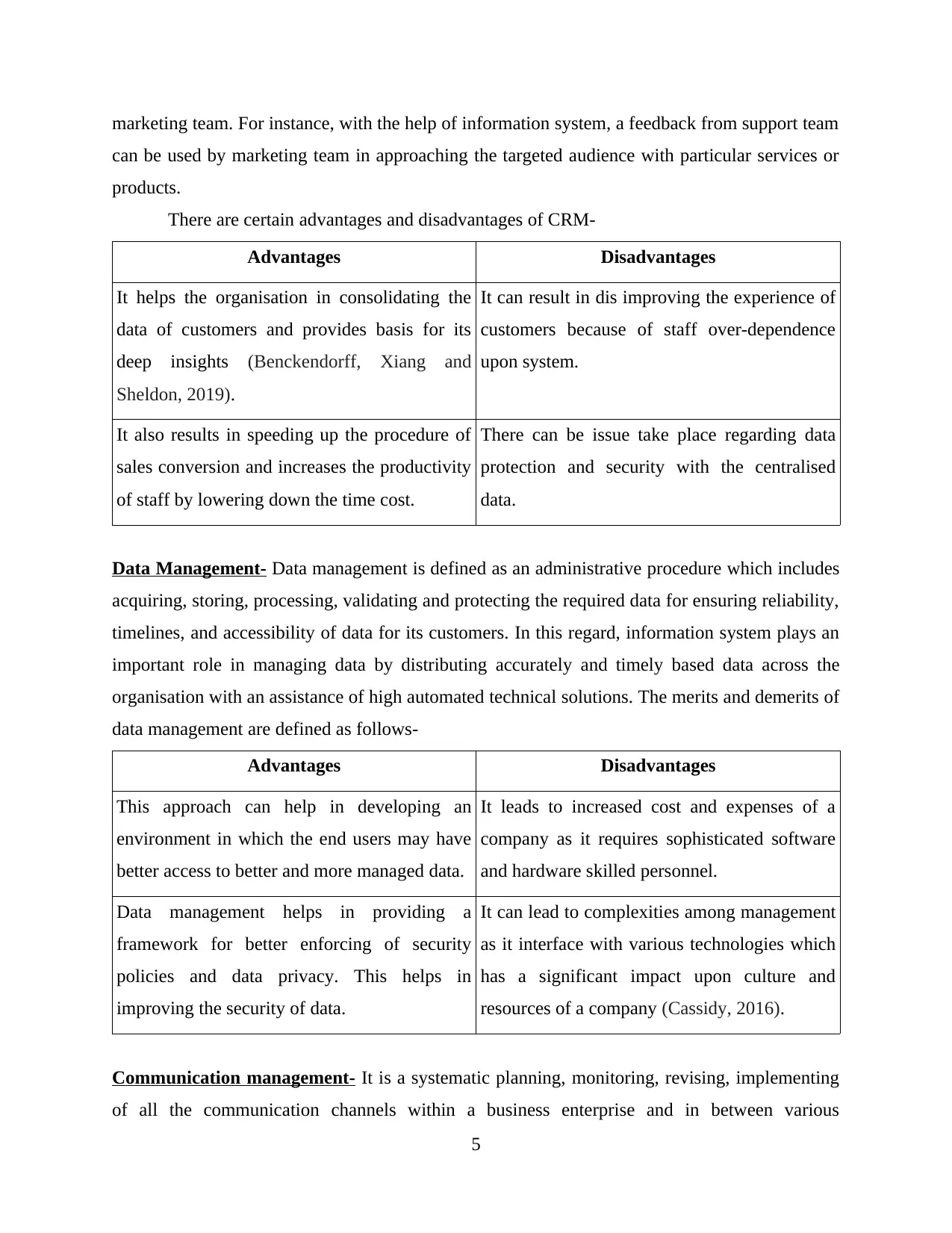
marketing team. For instance, with the help of information system, a feedback from support team
can be used by marketing team in approaching the targeted audience with particular services or
products.
There are certain advantages and disadvantages of CRM-
Advantages Disadvantages
It helps the organisation in consolidating the
data of customers and provides basis for its
deep insights (Benckendorff, Xiang and
Sheldon, 2019).
It can result in dis improving the experience of
customers because of staff over-dependence
upon system.
It also results in speeding up the procedure of
sales conversion and increases the productivity
of staff by lowering down the time cost.
There can be issue take place regarding data
protection and security with the centralised
data.
Data Management- Data management is defined as an administrative procedure which includes
acquiring, storing, processing, validating and protecting the required data for ensuring reliability,
timelines, and accessibility of data for its customers. In this regard, information system plays an
important role in managing data by distributing accurately and timely based data across the
organisation with an assistance of high automated technical solutions. The merits and demerits of
data management are defined as follows-
Advantages Disadvantages
This approach can help in developing an
environment in which the end users may have
better access to better and more managed data.
It leads to increased cost and expenses of a
company as it requires sophisticated software
and hardware skilled personnel.
Data management helps in providing a
framework for better enforcing of security
policies and data privacy. This helps in
improving the security of data.
It can lead to complexities among management
as it interface with various technologies which
has a significant impact upon culture and
resources of a company (Cassidy, 2016).
Communication management- It is a systematic planning, monitoring, revising, implementing
of all the communication channels within a business enterprise and in between various
5
can be used by marketing team in approaching the targeted audience with particular services or
products.
There are certain advantages and disadvantages of CRM-
Advantages Disadvantages
It helps the organisation in consolidating the
data of customers and provides basis for its
deep insights (Benckendorff, Xiang and
Sheldon, 2019).
It can result in dis improving the experience of
customers because of staff over-dependence
upon system.
It also results in speeding up the procedure of
sales conversion and increases the productivity
of staff by lowering down the time cost.
There can be issue take place regarding data
protection and security with the centralised
data.
Data Management- Data management is defined as an administrative procedure which includes
acquiring, storing, processing, validating and protecting the required data for ensuring reliability,
timelines, and accessibility of data for its customers. In this regard, information system plays an
important role in managing data by distributing accurately and timely based data across the
organisation with an assistance of high automated technical solutions. The merits and demerits of
data management are defined as follows-
Advantages Disadvantages
This approach can help in developing an
environment in which the end users may have
better access to better and more managed data.
It leads to increased cost and expenses of a
company as it requires sophisticated software
and hardware skilled personnel.
Data management helps in providing a
framework for better enforcing of security
policies and data privacy. This helps in
improving the security of data.
It can lead to complexities among management
as it interface with various technologies which
has a significant impact upon culture and
resources of a company (Cassidy, 2016).
Communication management- It is a systematic planning, monitoring, revising, implementing
of all the communication channels within a business enterprise and in between various
5
Paraphrase This Document
Need a fresh take? Get an instant paraphrase of this document with our AI Paraphraser
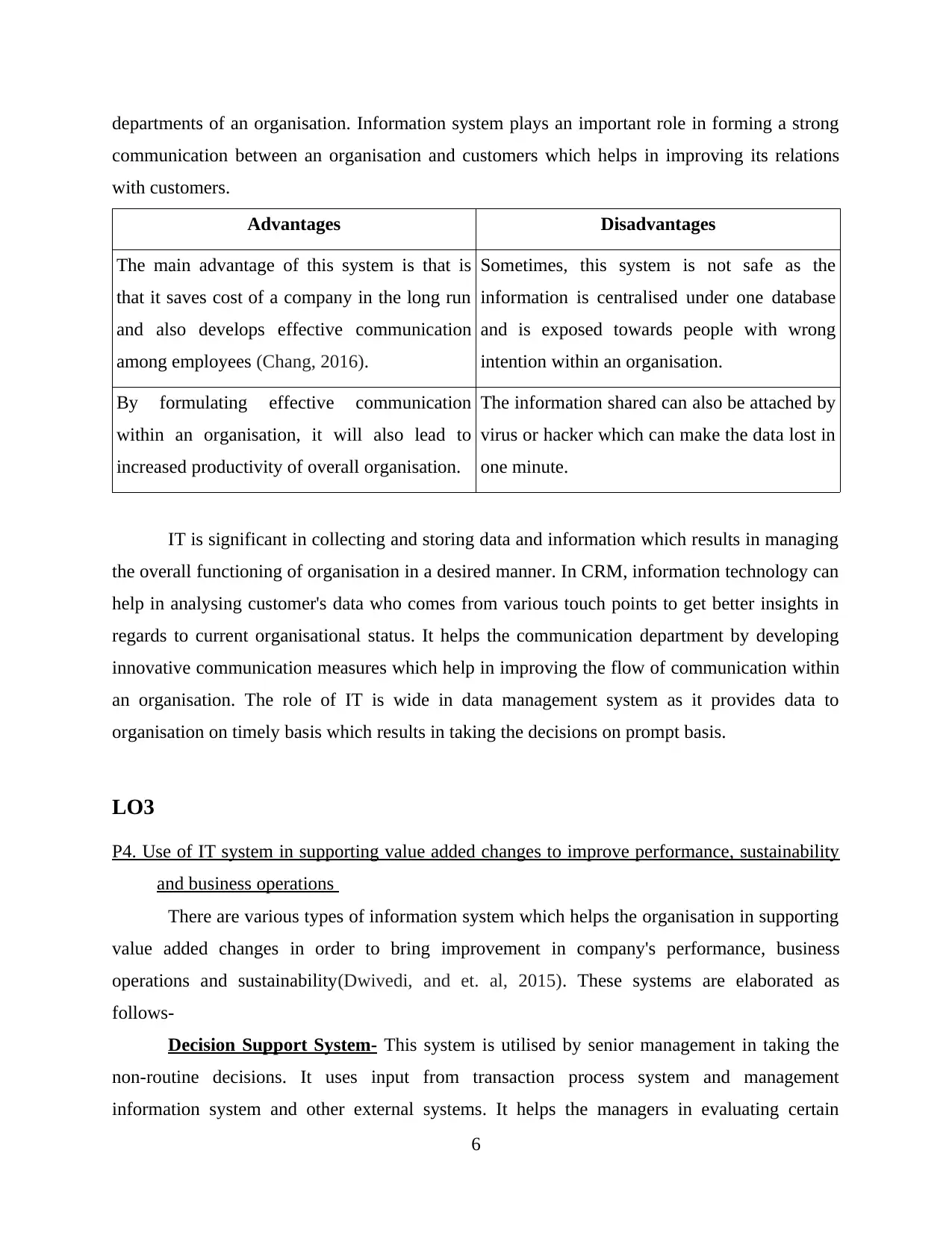
departments of an organisation. Information system plays an important role in forming a strong
communication between an organisation and customers which helps in improving its relations
with customers.
Advantages Disadvantages
The main advantage of this system is that is
that it saves cost of a company in the long run
and also develops effective communication
among employees (Chang, 2016).
Sometimes, this system is not safe as the
information is centralised under one database
and is exposed towards people with wrong
intention within an organisation.
By formulating effective communication
within an organisation, it will also lead to
increased productivity of overall organisation.
The information shared can also be attached by
virus or hacker which can make the data lost in
one minute.
IT is significant in collecting and storing data and information which results in managing
the overall functioning of organisation in a desired manner. In CRM, information technology can
help in analysing customer's data who comes from various touch points to get better insights in
regards to current organisational status. It helps the communication department by developing
innovative communication measures which help in improving the flow of communication within
an organisation. The role of IT is wide in data management system as it provides data to
organisation on timely basis which results in taking the decisions on prompt basis.
LO3
P4. Use of IT system in supporting value added changes to improve performance, sustainability
and business operations
There are various types of information system which helps the organisation in supporting
value added changes in order to bring improvement in company's performance, business
operations and sustainability(Dwivedi, and et. al, 2015). These systems are elaborated as
follows-
Decision Support System- This system is utilised by senior management in taking the
non-routine decisions. It uses input from transaction process system and management
information system and other external systems. It helps the managers in evaluating certain
6
communication between an organisation and customers which helps in improving its relations
with customers.
Advantages Disadvantages
The main advantage of this system is that is
that it saves cost of a company in the long run
and also develops effective communication
among employees (Chang, 2016).
Sometimes, this system is not safe as the
information is centralised under one database
and is exposed towards people with wrong
intention within an organisation.
By formulating effective communication
within an organisation, it will also lead to
increased productivity of overall organisation.
The information shared can also be attached by
virus or hacker which can make the data lost in
one minute.
IT is significant in collecting and storing data and information which results in managing
the overall functioning of organisation in a desired manner. In CRM, information technology can
help in analysing customer's data who comes from various touch points to get better insights in
regards to current organisational status. It helps the communication department by developing
innovative communication measures which help in improving the flow of communication within
an organisation. The role of IT is wide in data management system as it provides data to
organisation on timely basis which results in taking the decisions on prompt basis.
LO3
P4. Use of IT system in supporting value added changes to improve performance, sustainability
and business operations
There are various types of information system which helps the organisation in supporting
value added changes in order to bring improvement in company's performance, business
operations and sustainability(Dwivedi, and et. al, 2015). These systems are elaborated as
follows-
Decision Support System- This system is utilised by senior management in taking the
non-routine decisions. It uses input from transaction process system and management
information system and other external systems. It helps the managers in evaluating certain
6
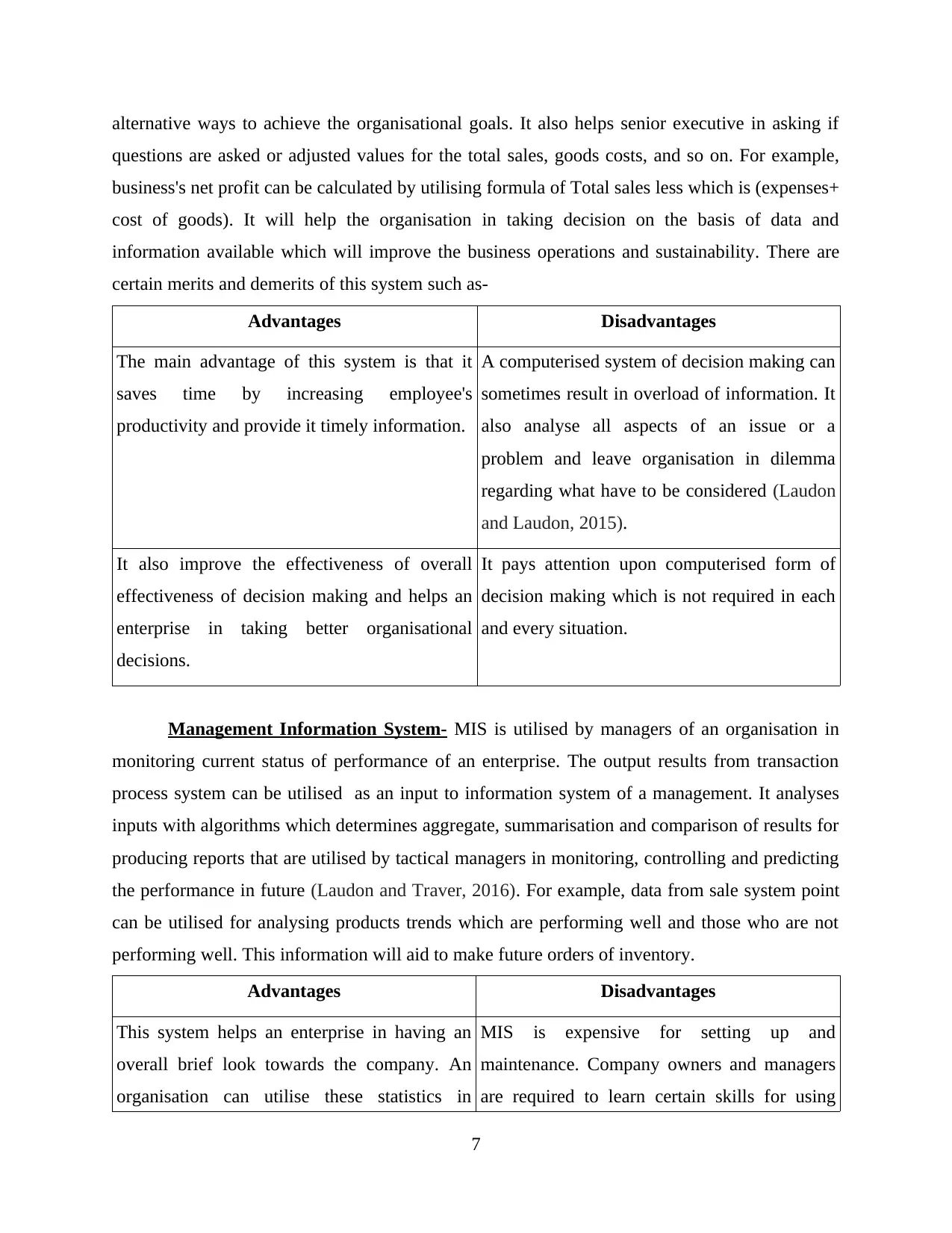
alternative ways to achieve the organisational goals. It also helps senior executive in asking if
questions are asked or adjusted values for the total sales, goods costs, and so on. For example,
business's net profit can be calculated by utilising formula of Total sales less which is (expenses+
cost of goods). It will help the organisation in taking decision on the basis of data and
information available which will improve the business operations and sustainability. There are
certain merits and demerits of this system such as-
Advantages Disadvantages
The main advantage of this system is that it
saves time by increasing employee's
productivity and provide it timely information.
A computerised system of decision making can
sometimes result in overload of information. It
also analyse all aspects of an issue or a
problem and leave organisation in dilemma
regarding what have to be considered (Laudon
and Laudon, 2015).
It also improve the effectiveness of overall
effectiveness of decision making and helps an
enterprise in taking better organisational
decisions.
It pays attention upon computerised form of
decision making which is not required in each
and every situation.
Management Information System- MIS is utilised by managers of an organisation in
monitoring current status of performance of an enterprise. The output results from transaction
process system can be utilised as an input to information system of a management. It analyses
inputs with algorithms which determines aggregate, summarisation and comparison of results for
producing reports that are utilised by tactical managers in monitoring, controlling and predicting
the performance in future (Laudon and Traver, 2016). For example, data from sale system point
can be utilised for analysing products trends which are performing well and those who are not
performing well. This information will aid to make future orders of inventory.
Advantages Disadvantages
This system helps an enterprise in having an
overall brief look towards the company. An
organisation can utilise these statistics in
MIS is expensive for setting up and
maintenance. Company owners and managers
are required to learn certain skills for using
7
questions are asked or adjusted values for the total sales, goods costs, and so on. For example,
business's net profit can be calculated by utilising formula of Total sales less which is (expenses+
cost of goods). It will help the organisation in taking decision on the basis of data and
information available which will improve the business operations and sustainability. There are
certain merits and demerits of this system such as-
Advantages Disadvantages
The main advantage of this system is that it
saves time by increasing employee's
productivity and provide it timely information.
A computerised system of decision making can
sometimes result in overload of information. It
also analyse all aspects of an issue or a
problem and leave organisation in dilemma
regarding what have to be considered (Laudon
and Laudon, 2015).
It also improve the effectiveness of overall
effectiveness of decision making and helps an
enterprise in taking better organisational
decisions.
It pays attention upon computerised form of
decision making which is not required in each
and every situation.
Management Information System- MIS is utilised by managers of an organisation in
monitoring current status of performance of an enterprise. The output results from transaction
process system can be utilised as an input to information system of a management. It analyses
inputs with algorithms which determines aggregate, summarisation and comparison of results for
producing reports that are utilised by tactical managers in monitoring, controlling and predicting
the performance in future (Laudon and Traver, 2016). For example, data from sale system point
can be utilised for analysing products trends which are performing well and those who are not
performing well. This information will aid to make future orders of inventory.
Advantages Disadvantages
This system helps an enterprise in having an
overall brief look towards the company. An
organisation can utilise these statistics in
MIS is expensive for setting up and
maintenance. Company owners and managers
are required to learn certain skills for using
7
⊘ This is a preview!⊘
Do you want full access?
Subscribe today to unlock all pages.

Trusted by 1+ million students worldwide
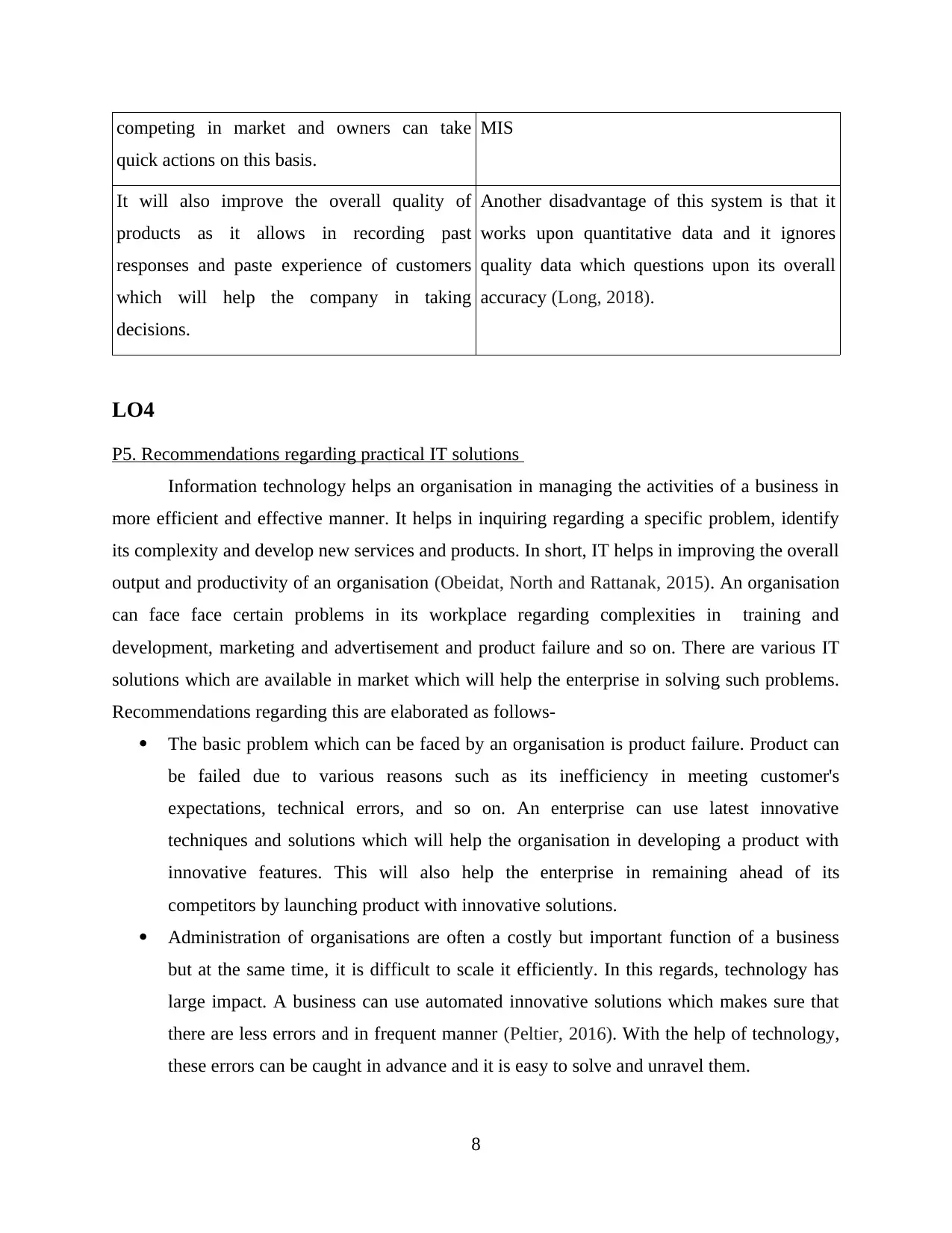
competing in market and owners can take
quick actions on this basis.
MIS
It will also improve the overall quality of
products as it allows in recording past
responses and paste experience of customers
which will help the company in taking
decisions.
Another disadvantage of this system is that it
works upon quantitative data and it ignores
quality data which questions upon its overall
accuracy (Long, 2018).
LO4
P5. Recommendations regarding practical IT solutions
Information technology helps an organisation in managing the activities of a business in
more efficient and effective manner. It helps in inquiring regarding a specific problem, identify
its complexity and develop new services and products. In short, IT helps in improving the overall
output and productivity of an organisation (Obeidat, North and Rattanak, 2015). An organisation
can face face certain problems in its workplace regarding complexities in training and
development, marketing and advertisement and product failure and so on. There are various IT
solutions which are available in market which will help the enterprise in solving such problems.
Recommendations regarding this are elaborated as follows-
The basic problem which can be faced by an organisation is product failure. Product can
be failed due to various reasons such as its inefficiency in meeting customer's
expectations, technical errors, and so on. An enterprise can use latest innovative
techniques and solutions which will help the organisation in developing a product with
innovative features. This will also help the enterprise in remaining ahead of its
competitors by launching product with innovative solutions.
Administration of organisations are often a costly but important function of a business
but at the same time, it is difficult to scale it efficiently. In this regards, technology has
large impact. A business can use automated innovative solutions which makes sure that
there are less errors and in frequent manner (Peltier, 2016). With the help of technology,
these errors can be caught in advance and it is easy to solve and unravel them.
8
quick actions on this basis.
MIS
It will also improve the overall quality of
products as it allows in recording past
responses and paste experience of customers
which will help the company in taking
decisions.
Another disadvantage of this system is that it
works upon quantitative data and it ignores
quality data which questions upon its overall
accuracy (Long, 2018).
LO4
P5. Recommendations regarding practical IT solutions
Information technology helps an organisation in managing the activities of a business in
more efficient and effective manner. It helps in inquiring regarding a specific problem, identify
its complexity and develop new services and products. In short, IT helps in improving the overall
output and productivity of an organisation (Obeidat, North and Rattanak, 2015). An organisation
can face face certain problems in its workplace regarding complexities in training and
development, marketing and advertisement and product failure and so on. There are various IT
solutions which are available in market which will help the enterprise in solving such problems.
Recommendations regarding this are elaborated as follows-
The basic problem which can be faced by an organisation is product failure. Product can
be failed due to various reasons such as its inefficiency in meeting customer's
expectations, technical errors, and so on. An enterprise can use latest innovative
techniques and solutions which will help the organisation in developing a product with
innovative features. This will also help the enterprise in remaining ahead of its
competitors by launching product with innovative solutions.
Administration of organisations are often a costly but important function of a business
but at the same time, it is difficult to scale it efficiently. In this regards, technology has
large impact. A business can use automated innovative solutions which makes sure that
there are less errors and in frequent manner (Peltier, 2016). With the help of technology,
these errors can be caught in advance and it is easy to solve and unravel them.
8
Paraphrase This Document
Need a fresh take? Get an instant paraphrase of this document with our AI Paraphraser
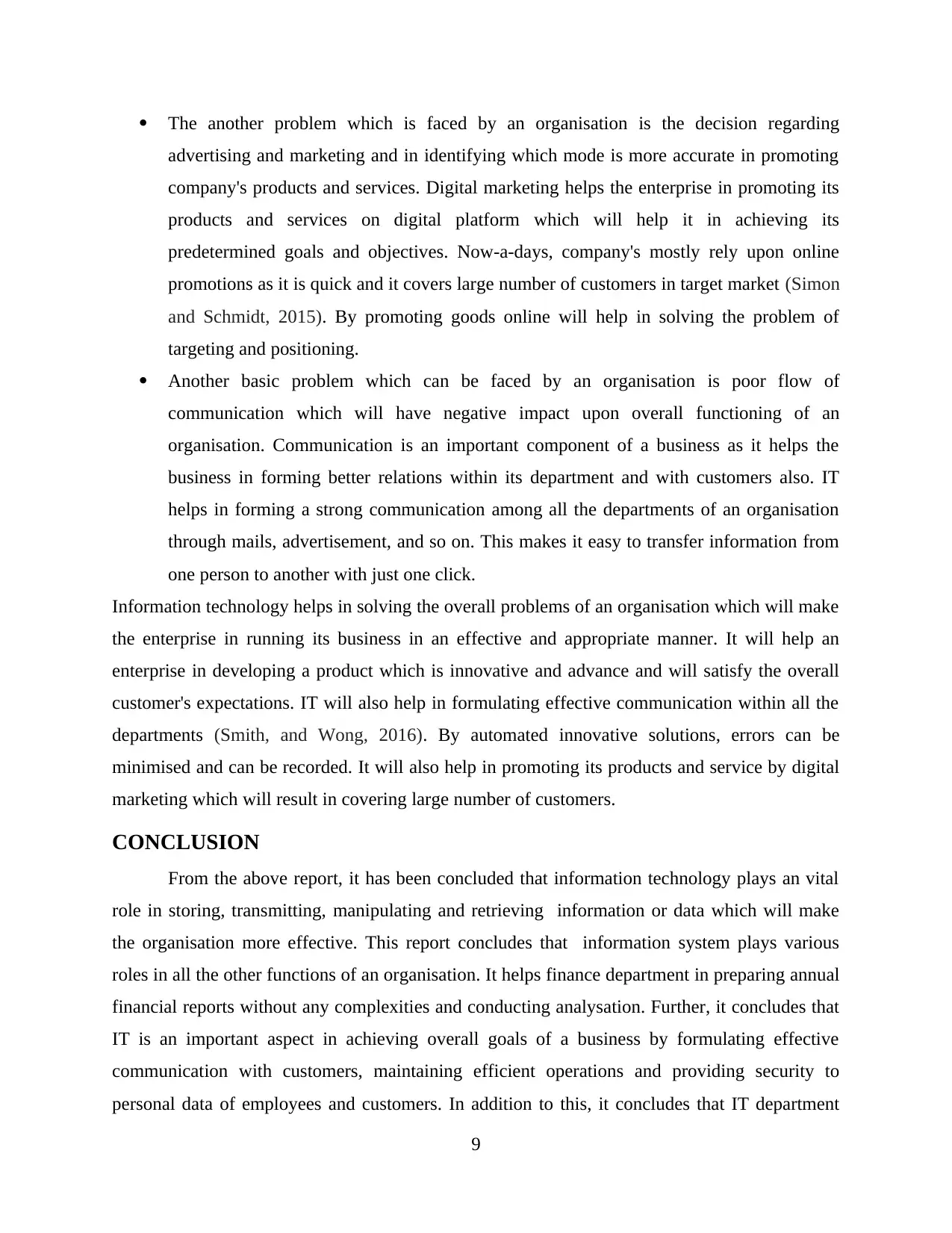
The another problem which is faced by an organisation is the decision regarding
advertising and marketing and in identifying which mode is more accurate in promoting
company's products and services. Digital marketing helps the enterprise in promoting its
products and services on digital platform which will help it in achieving its
predetermined goals and objectives. Now-a-days, company's mostly rely upon online
promotions as it is quick and it covers large number of customers in target market (Simon
and Schmidt, 2015). By promoting goods online will help in solving the problem of
targeting and positioning.
Another basic problem which can be faced by an organisation is poor flow of
communication which will have negative impact upon overall functioning of an
organisation. Communication is an important component of a business as it helps the
business in forming better relations within its department and with customers also. IT
helps in forming a strong communication among all the departments of an organisation
through mails, advertisement, and so on. This makes it easy to transfer information from
one person to another with just one click.
Information technology helps in solving the overall problems of an organisation which will make
the enterprise in running its business in an effective and appropriate manner. It will help an
enterprise in developing a product which is innovative and advance and will satisfy the overall
customer's expectations. IT will also help in formulating effective communication within all the
departments (Smith, and Wong, 2016). By automated innovative solutions, errors can be
minimised and can be recorded. It will also help in promoting its products and service by digital
marketing which will result in covering large number of customers.
CONCLUSION
From the above report, it has been concluded that information technology plays an vital
role in storing, transmitting, manipulating and retrieving information or data which will make
the organisation more effective. This report concludes that information system plays various
roles in all the other functions of an organisation. It helps finance department in preparing annual
financial reports without any complexities and conducting analysation. Further, it concludes that
IT is an important aspect in achieving overall goals of a business by formulating effective
communication with customers, maintaining efficient operations and providing security to
personal data of employees and customers. In addition to this, it concludes that IT department
9
advertising and marketing and in identifying which mode is more accurate in promoting
company's products and services. Digital marketing helps the enterprise in promoting its
products and services on digital platform which will help it in achieving its
predetermined goals and objectives. Now-a-days, company's mostly rely upon online
promotions as it is quick and it covers large number of customers in target market (Simon
and Schmidt, 2015). By promoting goods online will help in solving the problem of
targeting and positioning.
Another basic problem which can be faced by an organisation is poor flow of
communication which will have negative impact upon overall functioning of an
organisation. Communication is an important component of a business as it helps the
business in forming better relations within its department and with customers also. IT
helps in forming a strong communication among all the departments of an organisation
through mails, advertisement, and so on. This makes it easy to transfer information from
one person to another with just one click.
Information technology helps in solving the overall problems of an organisation which will make
the enterprise in running its business in an effective and appropriate manner. It will help an
enterprise in developing a product which is innovative and advance and will satisfy the overall
customer's expectations. IT will also help in formulating effective communication within all the
departments (Smith, and Wong, 2016). By automated innovative solutions, errors can be
minimised and can be recorded. It will also help in promoting its products and service by digital
marketing which will result in covering large number of customers.
CONCLUSION
From the above report, it has been concluded that information technology plays an vital
role in storing, transmitting, manipulating and retrieving information or data which will make
the organisation more effective. This report concludes that information system plays various
roles in all the other functions of an organisation. It helps finance department in preparing annual
financial reports without any complexities and conducting analysation. Further, it concludes that
IT is an important aspect in achieving overall goals of a business by formulating effective
communication with customers, maintaining efficient operations and providing security to
personal data of employees and customers. In addition to this, it concludes that IT department
9
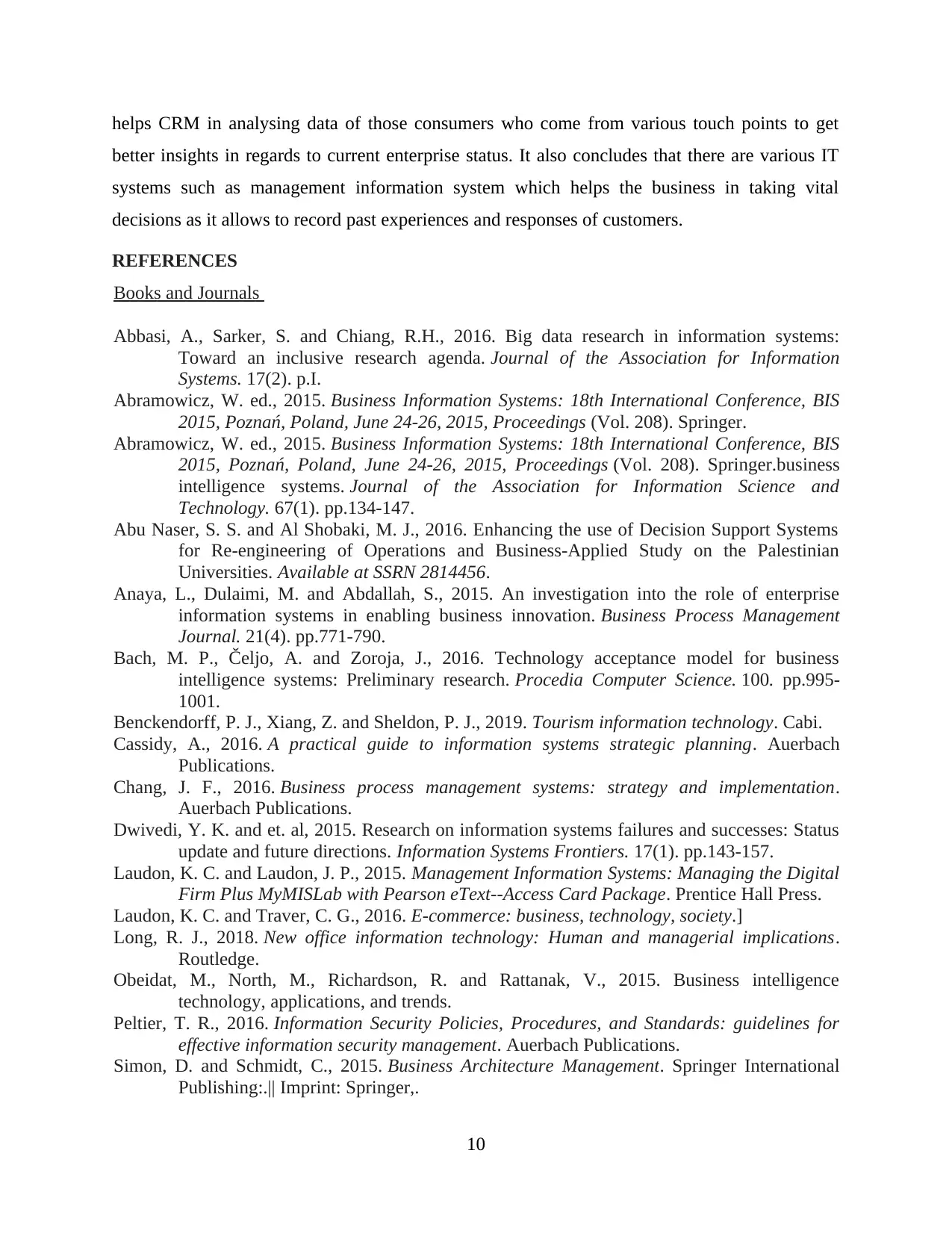
helps CRM in analysing data of those consumers who come from various touch points to get
better insights in regards to current enterprise status. It also concludes that there are various IT
systems such as management information system which helps the business in taking vital
decisions as it allows to record past experiences and responses of customers.
REFERENCES
Books and Journals
Abbasi, A., Sarker, S. and Chiang, R.H., 2016. Big data research in information systems:
Toward an inclusive research agenda. Journal of the Association for Information
Systems. 17(2). p.I.
Abramowicz, W. ed., 2015. Business Information Systems: 18th International Conference, BIS
2015, Poznań, Poland, June 24-26, 2015, Proceedings (Vol. 208). Springer.
Abramowicz, W. ed., 2015. Business Information Systems: 18th International Conference, BIS
2015, Poznań, Poland, June 24-26, 2015, Proceedings (Vol. 208). Springer.business
intelligence systems. Journal of the Association for Information Science and
Technology. 67(1). pp.134-147.
Abu Naser, S. S. and Al Shobaki, M. J., 2016. Enhancing the use of Decision Support Systems
for Re-engineering of Operations and Business-Applied Study on the Palestinian
Universities. Available at SSRN 2814456.
Anaya, L., Dulaimi, M. and Abdallah, S., 2015. An investigation into the role of enterprise
information systems in enabling business innovation. Business Process Management
Journal. 21(4). pp.771-790.
Bach, M. P., Čeljo, A. and Zoroja, J., 2016. Technology acceptance model for business
intelligence systems: Preliminary research. Procedia Computer Science. 100. pp.995-
1001.
Benckendorff, P. J., Xiang, Z. and Sheldon, P. J., 2019. Tourism information technology. Cabi.
Cassidy, A., 2016. A practical guide to information systems strategic planning. Auerbach
Publications.
Chang, J. F., 2016. Business process management systems: strategy and implementation.
Auerbach Publications.
Dwivedi, Y. K. and et. al, 2015. Research on information systems failures and successes: Status
update and future directions. Information Systems Frontiers. 17(1). pp.143-157.
Laudon, K. C. and Laudon, J. P., 2015. Management Information Systems: Managing the Digital
Firm Plus MyMISLab with Pearson eText--Access Card Package. Prentice Hall Press.
Laudon, K. C. and Traver, C. G., 2016. E-commerce: business, technology, society.]
Long, R. J., 2018. New office information technology: Human and managerial implications.
Routledge.
Obeidat, M., North, M., Richardson, R. and Rattanak, V., 2015. Business intelligence
technology, applications, and trends.
Peltier, T. R., 2016. Information Security Policies, Procedures, and Standards: guidelines for
effective information security management. Auerbach Publications.
Simon, D. and Schmidt, C., 2015. Business Architecture Management. Springer International
Publishing:.|| Imprint: Springer,.
10
better insights in regards to current enterprise status. It also concludes that there are various IT
systems such as management information system which helps the business in taking vital
decisions as it allows to record past experiences and responses of customers.
REFERENCES
Books and Journals
Abbasi, A., Sarker, S. and Chiang, R.H., 2016. Big data research in information systems:
Toward an inclusive research agenda. Journal of the Association for Information
Systems. 17(2). p.I.
Abramowicz, W. ed., 2015. Business Information Systems: 18th International Conference, BIS
2015, Poznań, Poland, June 24-26, 2015, Proceedings (Vol. 208). Springer.
Abramowicz, W. ed., 2015. Business Information Systems: 18th International Conference, BIS
2015, Poznań, Poland, June 24-26, 2015, Proceedings (Vol. 208). Springer.business
intelligence systems. Journal of the Association for Information Science and
Technology. 67(1). pp.134-147.
Abu Naser, S. S. and Al Shobaki, M. J., 2016. Enhancing the use of Decision Support Systems
for Re-engineering of Operations and Business-Applied Study on the Palestinian
Universities. Available at SSRN 2814456.
Anaya, L., Dulaimi, M. and Abdallah, S., 2015. An investigation into the role of enterprise
information systems in enabling business innovation. Business Process Management
Journal. 21(4). pp.771-790.
Bach, M. P., Čeljo, A. and Zoroja, J., 2016. Technology acceptance model for business
intelligence systems: Preliminary research. Procedia Computer Science. 100. pp.995-
1001.
Benckendorff, P. J., Xiang, Z. and Sheldon, P. J., 2019. Tourism information technology. Cabi.
Cassidy, A., 2016. A practical guide to information systems strategic planning. Auerbach
Publications.
Chang, J. F., 2016. Business process management systems: strategy and implementation.
Auerbach Publications.
Dwivedi, Y. K. and et. al, 2015. Research on information systems failures and successes: Status
update and future directions. Information Systems Frontiers. 17(1). pp.143-157.
Laudon, K. C. and Laudon, J. P., 2015. Management Information Systems: Managing the Digital
Firm Plus MyMISLab with Pearson eText--Access Card Package. Prentice Hall Press.
Laudon, K. C. and Traver, C. G., 2016. E-commerce: business, technology, society.]
Long, R. J., 2018. New office information technology: Human and managerial implications.
Routledge.
Obeidat, M., North, M., Richardson, R. and Rattanak, V., 2015. Business intelligence
technology, applications, and trends.
Peltier, T. R., 2016. Information Security Policies, Procedures, and Standards: guidelines for
effective information security management. Auerbach Publications.
Simon, D. and Schmidt, C., 2015. Business Architecture Management. Springer International
Publishing:.|| Imprint: Springer,.
10
⊘ This is a preview!⊘
Do you want full access?
Subscribe today to unlock all pages.

Trusted by 1+ million students worldwide
1 out of 13
Related Documents
Your All-in-One AI-Powered Toolkit for Academic Success.
+13062052269
info@desklib.com
Available 24*7 on WhatsApp / Email
![[object Object]](/_next/static/media/star-bottom.7253800d.svg)
Unlock your academic potential
Copyright © 2020–2025 A2Z Services. All Rights Reserved. Developed and managed by ZUCOL.





